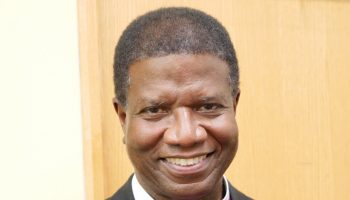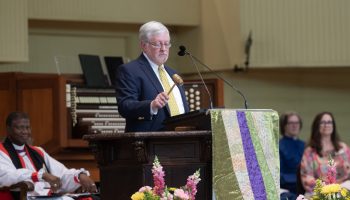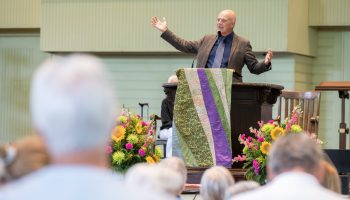
Column by Mary Lee Talbot
“I learned about Jesus in Spanish, and I learned about misericordia in Spanish. My teacher, Sister Linda, put the word ‘miseri’ on one side of the blackboard and ‘cordia’ on the other side. She put a heart in the middle and an arrow pointing toward the word ‘miseri,’ to put our hearts in the pain of others, in human suffering,” said Sister Teresa Maya.
Sister Teresa preached at the 9:15 a.m. Tuesday morning worship service in the Amphitheater. Her sermon title was “The One Who Showed Mercy,” and the scripture reading was Luke 10:25–37, the story of the Good Samaritan.
As Sister Teresa studied theology, she learned that in English “mercy” carries more the meaning of forgiveness or clemency. “It doesn’t matter how you say it. We always pair misery with compassion,” she told the congregation. “Our times are desperate for compassion. It is the only way to have hope today, and the only way to be a Christiam today.”
Before the pandemic, there were many unaccompanied children, women and people with families coming into the San Antonio area. Sister Norma, a friend of Sister Teresa’s, was running a shelter to help newly arrived families. A local sheriff came in one day and asked, “What is going on?” Sister Norma said, “We are restoring human dignity.” The sheriff came back later with more people and diapers and other supplies for the people.
Another friend of Sister Teresa’s, Fernanda, was working with migrant children who had arrived alone. They were drawing pictures of their hopes, and one child asked for a home for her parents, another for peace, but the third said, “I can’t dream; my heart is broken.”
Sister Teresa said, “Twenty-five percent of the migrants are children. Most Rev. Mark. J. Seitz, bishop of the dioceses of El Paso, reminds us of this statistic. He noted that a Jewish donor to the work to help the children said, ‘I was once one of those children.’ Networks were created; we were all good Samaritans.”
But Catholic Charities is no longer funded to do this work. The migrants, Sister Teresa said, have nowhere to go. “The children are still here, and they are still children, but they are afraid and alone. Which one is the neighbor? The response is barely audible. How can we still be good Samaritans?”
Border Bishops and Bishops Responsible for Ministry with Migrants in North America, Central America and the Caribbean issued a pastoral letter in December 2024: “He Saw Them, He Drew Near To Them & He Cared For Them, — Walking with those who migrate, refugees, internally displaced persons and survivors of trafficking.”
Sister Teresa used the title, “He Saw Them, He Drew Near to Them & He Cared for Them,” as the outline for the rest of her sermon.
The first invitation, she said, is to see them. The robbers saw the man walking the road to Jericho and attacked him. The priest and the Levite saw the man but moved to the other side of the road. “This was not a scandal at that time because they would have been unclean. The scandal was that the Samaritan, the ‘other,’ saw the man and had compassion. He did not just see the person. He saw as God sees — with compassion,” said Sister Teresa.
She continued, “The Samaritan was closest to God. What did he see? How did he see? Does it make us wonder or uncomfortable that we see too much suffering, and we feel empathetic, yes, but compassionate? No. The children who are hungry, have no medicine, no home, no school, do we see them with compassion?”
The second invitation in the pastoral letter is to draw near to them. Sister Teresa told the congregation, “We need to be able to move closer, we need to stand close and know people’s names, their journeys. There is a bus station ministry in San Antonio where interfaith volunteers provide a welcome to migrants. They are told by the border patrol to find the abuelas, the grandmothers. They can help you read a map, find the right bus and explain winter in Nebraska if you are from Honduras.”
Drawing near helps us find the human side of the story. “When we draw near, we hear the hope and resilience of these families. We learn their names, their fears, and they become part of the fabric of our lives, and we become part of theirs,” she said.
The third invitation is to take care of them. The Samaritan did something, and “we need to pay attention,” Sister Teresa said.
Jesus was having an honest conversation with the lawyer. The lawyer wanted to know what he needed to do to inherit eternal life. Jesus asked him what his faith, his tradition told him, and the lawyer answered. Jesus told him his answer was good, but the lawyer pressed Jesus, asking, “Who is my neighbor?”
“We might ask, ‘What is a neighbor?’” said Sister Teresa. “How is a neighbor different from a friend or from family? Is it possible to know who our neighbor is?” We answer that, she told the congregation, by our response to human suffering.
When Jesus asked the lawyer who he thought the neighbor was to the man who was robbed, how long did it take the lawyer to answer? “Our answer is a commitment. Responding is a vocation,” she said.
The lawyer’s answer, “the one who showed mercy,” is not the end of the parable, Sister Teresa told the congregation. “Jesus said, ‘Go, and do likewise.’ Generations before us opened hospitals, soup kitchens, shelters, nonprofits. Christianity is at its best when we go and do likewise.”
She continued, “It is our turn. How are we going and doing likewise, to be the one who saw, who drew near and took care? How do we restore human dignity? Go and do likewise.” The congregation applauded.
The Rev. Scott Maxwell, a Lutheran pastor serving at St. John’s Lutheran Church and an Episcopal church, presided. Elaine Hooker, prospect research associate for advancement at Chautauqua Institution, read the scripture. Owen Reyda, organ scholar, performed “Mit innigem Ausdruck,” from Six Canonic Studies, Op. 56 No. 2 by Robert Schumann, for the prelude on the Massey Memorial Organ. The Motet Choir performed “The Secret of Christ,” music by Richard Shephard and text from Isaiah 42:14–16, Revelation 22:1–3 and “The Pilgrim Prayer” (based on Colossians 4:2–4) by the Rev. Canon Derrick Walters. The choir was under the direction of Joshua Stafford, director of sacred music and the Jared Jacobsen Chair for the Organist, and accompanied by Laura Smith, organ scholar, on the Massey organ. Stafford performed “Nicht zu schnell und sehr markiert,” from Four Sketches for Pedal Piano, Op. 58, No. 2, by Robert Schumann. Support for this week’s chaplaincy and preaching is provided by the Reverend Leonard J. Ebel Chaplaincy.




